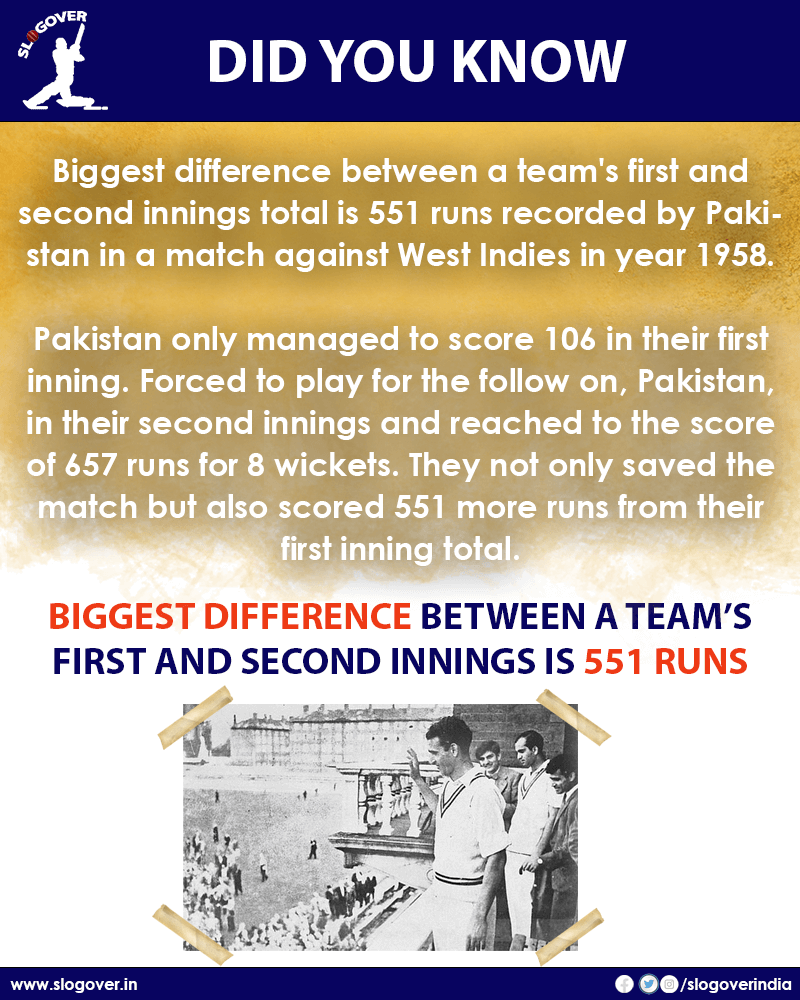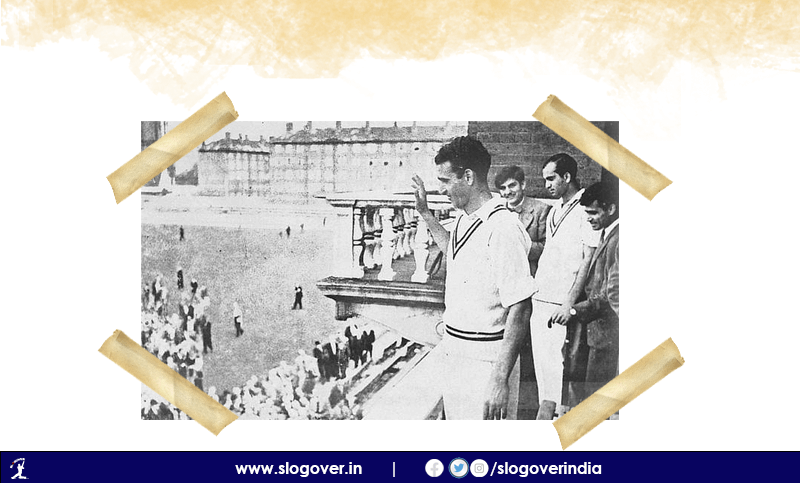
Table of Contents
Biggest difference between a team’s first and second innings
Do you know what is the biggest difference between a team’s first and second innings total? It is 551 runs recorded by Pakistan in a match against West Indies in year 1958.
In a match between Pakistan and West Indies in Jan 1958 at Bridgetown ground, West Indies scored a massive 579/5 in their 1st inning and in reply, Pakistan only managed to score 106 in their first inning.
Forced to play for the follow on, Pakistan, played brilliantly in their second innings and reached to the score of 657 runs for 8 wickets. They not only saved the match but also scored 551 more runs from their first inning total. This is also the only instance of a team’s first and second inning difference by more than 500 runs.

Click Here for more details of this Match.
Biggest difference between a team’s first and second innings
| Team | First Innings Score | Second Innings Score | Diff | Opposition | Ground | Match Date |
| Pakistan | 106 | 657/8d | 551 | West Indies | Bridgetown | 17-Jan-58 |
| New Zealand | 174 | 671/4 | 497 | Sri Lanka | Wellington | 31-Jan-91 |
| New Zealand | 192 | 680/8d | 488 | India | Wellington | 14-Feb-14 |
| India | 171 | 657/7d | 486 | Australia | Eden Gardens | 11-Mar-01 |
| West Indies | 590 | 134 | 456 | India | Wankhede | 22-Nov-11 |
| Pakistan | 579/3d | 123 | 456 | West Indies | Dubai (DSC) | 13-Oct-16 |
| Bangladesh | 595/8d | 160 | 435 | New Zealand | Wellington | 12-Jan-17 |
| Zimbabwe | 131 | 563/9d | 432 | West Indies | Harare | 27-Jul-01 |
| West Indies | 133 | 564/8 | 431 | New Zealand | Bridgetown | 23-Mar-72 |
| England | 139 | 570/7d | 431 | South Africa | Durban | 26-Dec-04 |

Causes for differences in a team’s first and second innings runs
In the game of cricket, one of the biggest differences between a team’s first and second innings is the pitch conditions. The pitch, which is the playing surface on which the game is played, can change significantly from the first innings to the second.
During the first innings, the pitch is usually fresh and offers more bounce and pace for the bowlers. This can make it difficult for the batsmen to score runs. On the other hand, in the second innings, the pitch can become worn and provide less assistance to the bowlers. This can make it easier for the batsmen to score runs.
Another difference between the first and second innings is the mindset of the teams. In the first innings, the team that is batting will be looking to score as many runs as possible to set a challenging target for the opposing team. In the second innings, the team that is batting will be looking to bat out the remaining overs to avoid losing the match. This can lead to different strategies and approaches being used by the teams.
The team that is fielding first also have to make adjustments to their strategies, as they will have to chase the target set by the first team in the second innings. This can change the way they approach the game, especially in terms of the field placements and the use of different bowlers.
In addition, the weather conditions can also play a big role in the difference between the first and second innings. If the weather is hot and dry, the pitch may become dry and cracked, making it difficult for the bowlers to get any movement off the pitch. In contrast, if the weather is wet, the pitch may become damp and slow, making it easier for the batsmen to score runs.
Overall, the biggest difference between a team’s first and second innings is the change in pitch conditions and the different strategies and approaches used by the teams as a result. With both teams have different objectives to achieve in the first and second innings, it makes the game more challenging and exciting for the players and the spectators.
FAQs
What is the biggest difference of runs between a team’s first and second innings in test history?
The biggest difference of runs between a team’s first and second innings in test history is 551 runs in a match between Pakistan and West Indies.
Why do teams often score more runs in their second innings?
Teams often score more runs in their second innings because the pitch conditions have changed and are more favorable for batting. Additionally, in the second innings, the team is aware of the target they need to chase or defend, which can influence their approach to batting.
Back to Home
#Slogover #DidYouKnowCard #Cricket #CricketStories #CricketRecords #SlogoverRecords
Refer to Best Cricket Records Website ESPNCrickInfo for more such interesting information.

